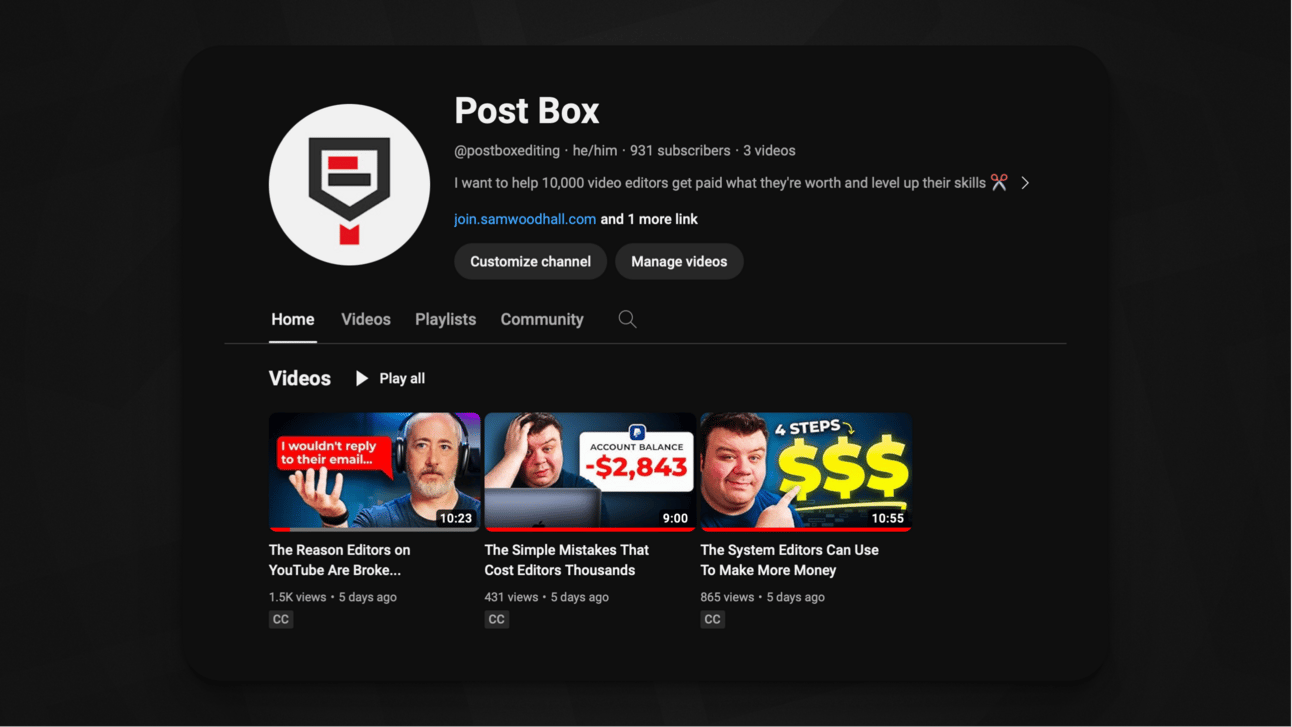- Post Box
- Posts
- The Biggest Challenges That YouTube Editors Face
The Biggest Challenges That YouTube Editors Face
Today, I cover the biggest challenges that YouTube editors face when growing their business
Reading time: 4 minutes
Being an editor on YouTube is like being a cowboy in the Wild West. Filled with challenges in a very cut throat world, where there is a real struggle for survival.
Then you have the traditional media world, where you have bigger budgets from corporate and commercial clients, along with much more professional working standards.
Now unfortunately, the somewhat upper-class professionalism hasn’t made its way into YouTube’s creator economy completely just yet. You have a few great opportunities here and there, but it is like sifting for gold dust.
The challenges YouTube editors face…
So in today’s newsletter, I’m going to talk about the challenges that most YouTube editors face, such as;
Navigating rates and what happens when you go too low
Finding and maintaining clients
Understanding how to determine your value
And how they can overcome them.
1. The Domino Effect of Low Balling Rates
Editors often opt for rock-bottom rates to secure gigs, but it's not the smartest move. Setting an arbitrary figure not only limits your future opportunities but also affects your fellow editors.
Most editors, especially newcomers, charge between $50 - $100 per video, sometimes less to outbid competitors.
This approach is harmful as it establishes a standard rate that impacts every editor seeking work. Creators may boast, "I paid only $40 for this editor," creating a cycle where others struggle to earn a living due to unreasonably low rates.
In traditional freelance editing, a day rate is usually derived from your hourly rate. For instance, a $25 per hour rate results in a $200 day rate ($25 x 8hrs = $200).
While rates for inexperienced US editors range from $200 to $500 per day, experienced ones can go for $700 or even $1000 per day.
So why hasn't this trend reached YouTube?
Simply put, many creators can't afford editors. Relying on ads, fan funding, and sponsorships, they barely meet their needs without considering the editor's requirements.
This is a friction point that creators need to get better at. Creators are afraid of monetising their audience, while also wanting the benefit of growth and what it entails. You can’t have one without the other.
It's not your duty to lower your rates to meet the client's needs. But, If you choose to work with them, or it's your only option, then by all means go for it.
If you have to take certain opportunities because life demands it, there’s no shame in that.
But remember, your rate doesn't reflect the quality of your skills, it reflects the quality of your clients
2. But how do I get clients if my rates are so high?
Now, let's dive into strategy. High rates may scare off 90% of potential clients.
Good.
Because you're not after 90% of clients, are you? You’re after clients offering:
Meaningful work
Respect for your creativity
Fair compensation for your skills
Don’t get me wrong, everyone has to start somewhere, and it’s usually the case for many people. But can you get all of that editing for low-paying clients? I don’t think so.
So, how do you find those unicorn clients?
Establish yourself as "the editor" in a specific niche you want to work in, something like finance, home improvement, gaming, etc.
Other editors may exist in these niches already, but you have an advantage. Identify what they don't offer and provide it to the clients you want to work for.
Build portfolios addressing client problems, positioning your services as solutions. This makes it easier to retain and attract clients in the same industry.
However, a piece of advice: research clients that are making money.
Do you want to edit for the Twitch streamer making pennies or the business-focused creator that can sustain you as an editor?
I’m guessing it’s the latter. Treat this as a business, evaluate your value, and consider how you make a difference in your clients' lives and businesses.
3. How do you discover your value?
Once you've thoroughly researched your clients and understand their needs, you're ready to market solutions to their problems.
Think of yourself not just as an editor, but as a problem solver.
Identify issues like poor storytelling or opportunities to enhance retention. Present these solutions to your clients, demonstrating how you can make a difference.
How? Build a portfolio showcasing your skills using their existing content. Create examples that illustrate the before-and-after effect of your work.
After gauging the value they'll gain by hiring you, you can then determine the price of your work.
Clients measure success in various ways:
Results
Sentiment
Sales
When clients grasp the benefits they'll receive, your pricing should reflect the value you bring to their specific goals.
It goes beyond just editing hours; it encompasses the transformative impact on their content and overall success metrics.
Use what you can do as a marketing strategy. Show how you’re the best person to solve their problem.
By adopting this problem-solving approach and presenting a compelling portfolio, you position yourself as a valuable asset, allowing you to confidently set your editing rates.
In case you missed it…
We’ve launched the Post Box YouTube Channel!
We have three videos up right now for people to sink their teeth into, with more on the way very soon.

Check out the videos, and if you like them, be sure to subscribe!
And until next time, happy editing!
Sam 👋🏻
Reply